Every morning, I used to struggle with creating the perfect breakfast. Scrambled eggs seemed like a simple protein-rich food. But achieving that creamy, restaurant-quality texture always eluded me. This quick meal became my culinary challenge until I discovered the secrets to making truly extraordinary scrambled eggs.
Whether you’re a busy professional or a home cook, mastering scrambled eggs is key. With just a few techniques, you can turn ordinary eggs into a delectable morning sensation. This will impress your family and friends.
Key Takeaways
- Fresh eggs create the creamiest scrambled texture
- Proper pan temperature is crucial for perfect eggs
- Whisking technique impacts final egg consistency
- Butter adds superior flavor compared to other fats
- Cooking time determines egg tenderness
Essential Equipment and Ingredients for Perfect Scrambled Eggs
Making great scrambled eggs begins with the right tools and ingredients. Your kitchen setup can greatly affect the taste and texture of your dish. It can turn a simple meal into a true delight.
Required Kitchen Tools
To make perfect scrambled eggs, you need a few key tools:
- A nonstick skillet for smooth, easy cooking
- A reliable whisk for blending eggs well
- A spatula for gentle stirring and scraping
- A mixing bowl for combining ingredients
Basic Ingredients List
Scrambled eggs are all about simplicity. Here’s what you’ll need:
| Ingredient | Purpose | Recommended Amount |
|---|---|---|
| Fresh eggs | Primary protein base | 2-3 eggs per serving |
| Butter or olive oil | Cooking fat | 1-2 tablespoons |
| Salt | Flavor enhancement | Pinch to taste |
| Water (optional) | Added fluffiness | 1-1.5 teaspoons per egg |
Choosing the Right Eggs
Not all eggs are the same. Fresh eggs are key for creamy, tasty scrambled eggs. Eggs from pasture-raised or farm-fresh sources usually taste and feel better.
“The quality of your eggs will directly impact the final taste and texture of your scrambled eggs.” – Culinary Expert
Pro tip: Always crack your eggs into a separate bowl. This avoids shell fragments and ensures top-quality eggs.
The Science Behind Fluffy Scrambled Eggs
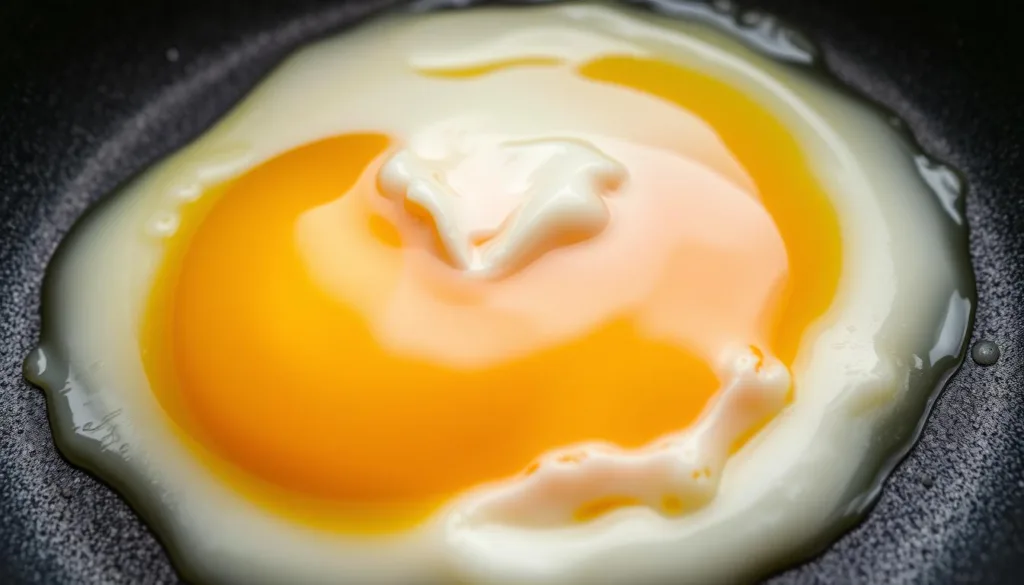
Scrambled eggs can be either fluffy or flat, depending on the science behind them. The key is protein coagulation, which turns liquid eggs into creamy curds. When eggs are heated, proteins unwind and then reconnect, giving scrambled eggs their texture.
Getting the right heat is crucial for fluffy eggs. Chefs say to cook eggs at low to medium-low temperatures. This slow cooking lets proteins set properly. Cooking too fast can make eggs tough and rubbery.
“The secret to perfect scrambled eggs lies in gentle heat and patient cooking” – Professional Chef
Key Factors for Fluffy Eggs
- Add 1-2 teaspoons of ice water per egg to enhance fluffiness
- Whisk eggs until slightly frothy to incorporate air bubbles
- Cook eggs for 2-3 minutes over low heat
- Remove eggs from heat when 90% cooked to prevent overcooking
Adding salt to eggs 15 minutes before cooking can make them softer. Chefs recommend using about ½ tablespoon of butter per egg. This makes the scrambled eggs rich and creamy.
Water’s Magic Touch
Adding a tablespoon of water per egg is a surprising trick. It makes eggs steamy and puffy without extra fat. The water creates steam pockets, making eggs light and fluffy.
Pro tip: Gentle, continuous stirring during cooking helps create small, tender curds that contribute to a luxurious texture.
Preparing Your Ingredients Before Cooking
Creating the perfect scrambled eggs starts with careful preparation. Knowing how to handle your egg mixture and ingredients can turn an ordinary breakfast into a culinary delight.
Proper Egg Whisking Technique
Whisking is key for light and fluffy scrambled eggs. Use a wire whisk to beat your eggs until they’re frothy and fully mixed. This incorporates air, making the eggs soft.
- Whisk vigorously for 30-45 seconds
- Ensure no streaks of egg whites remain
- Use a balloon whisk for best results
Adding Liquid Components
Liquid ingredients can greatly improve your egg mixture’s texture. Water, milk, and cream each have unique qualities. The right choice depends on what you want.
| Liquid Component | Effect on Eggs | Recommended Quantity |
|---|---|---|
| Whole Milk | Adds creaminess | 1/4 cup per 4 eggs |
| Heavy Cream | Increases richness | 1 tablespoon per 2 eggs |
| Water | Creates lighter texture | 1-2 tablespoons per 4 eggs |
Seasoning Options
Seasoning your egg mixture can enhance its flavor. Salt and pepper are classic, but try different herbs and spices too.
“The secret to great scrambled eggs is not just in the cooking, but in the preparation.” – Professional Chef
- Use kosher or sea salt for best flavor
- Freshly ground black pepper adds depth
- Consider adding herbs like chives or parsley
Pro tip: Season your eggs just before cooking to prevent moisture loss and maintain the eggs’ delicate texture. A pinch of salt and a few grinds of pepper can make all the difference in your final dish.
Mastering the Perfect Pan Temperature
Getting scrambled eggs just right starts with the pan temperature. Cooking on medium heat is key. It cooks eggs gently and evenly, without burning them.
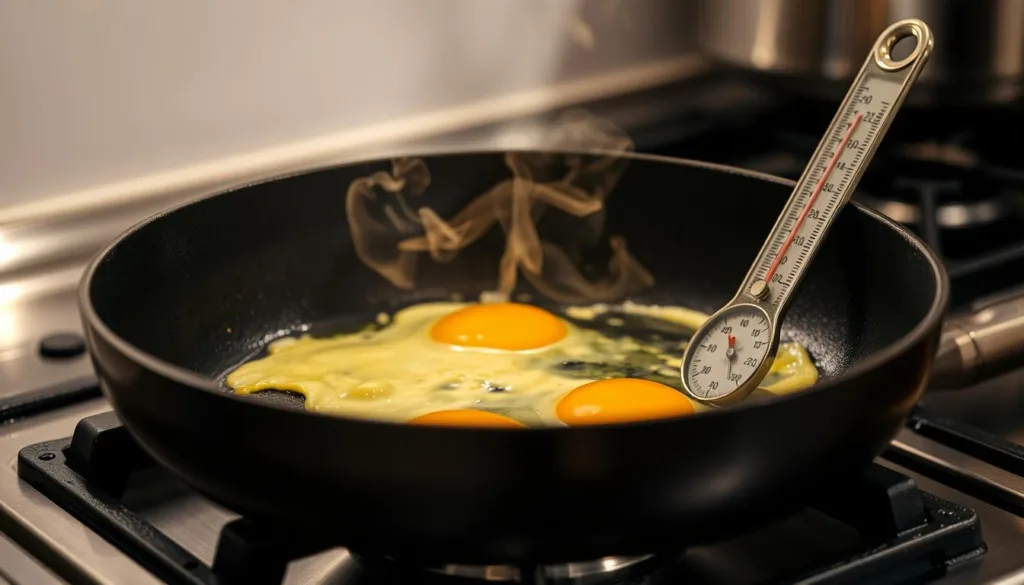
First, preheat your pan. A hot pan ensures butter melts evenly. This makes the cooking surface smooth. Here are some tips for the best results:
- Start with a clean, dry pan
- Set your stove to medium heat
- Let the pan warm up for about 1-2 minutes
- Add butter and watch for gentle bubbling
“The right temperature makes all the difference between good and extraordinary scrambled eggs.”
Controlling the temperature is all about making small adjustments. If the pan is too hot, your eggs will be tough and dry. Keep the heat at a steady medium to cook them slowly.
| Heat Level | Egg Texture Result |
|---|---|
| Low Heat | Soft, creamy eggs |
| Medium Heat | Perfect, fluffy texture |
| High Heat | Rubbery, overcooked eggs |
Pro tip: If the butter browns too fast, your pan is too hot. Just take it off the heat for a bit to cool it down.
Scrambled Eggs: The Basic Cooking Method
Learning to make scrambled eggs is all about precision and technique. The way you fold eggs and manage curds can turn a simple dish into a masterpiece. Your cooking time and method are key to making creamy scrambled eggs.
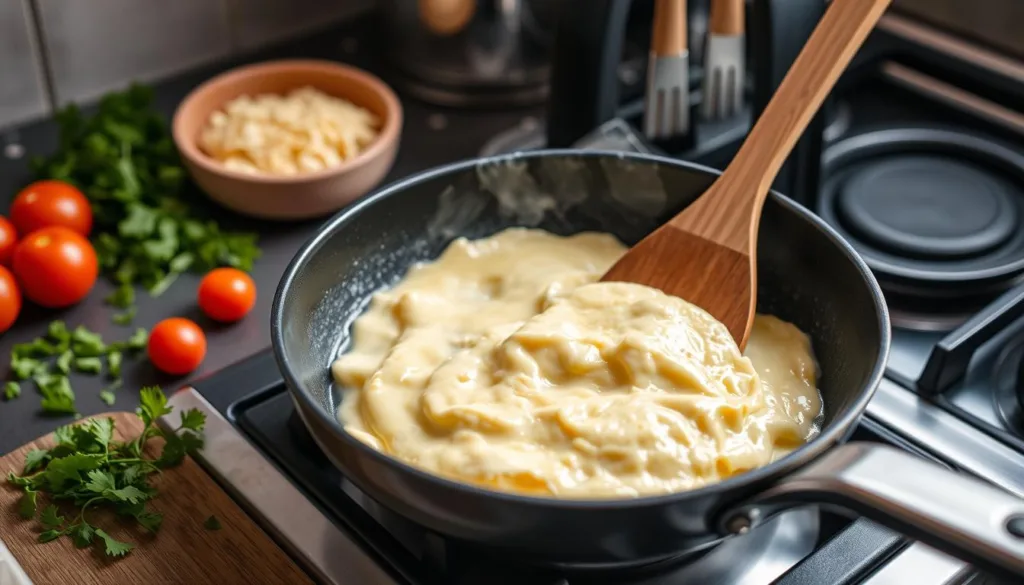
Butter vs Oil Selection
Choosing the right fat is important when making scrambled eggs. Most chefs prefer butter for its rich flavor and ability to prevent sticking. Use unsalted butter and melt it until it’s golden but not brown. This ensures the best flavor and prevents burning.
- Use unsalted butter for best results
- Melt butter on medium-low heat
- Look for a golden color before adding eggs
Proper Stirring Technique
The secret to creamy scrambled eggs is in your stirring. Use a silicone or heatproof spatula to gently push cooked eggs toward the center. This lets uncooked eggs flow out, creating soft, delicate curds.
“Gentle folding is the key to achieving cloud-like scrambled eggs”
Timing Your Cook
Cooking time is crucial for perfect scrambled eggs. Start with medium-low heat and cook for 2-3 minutes total. Take the eggs off heat when they’re slightly wet but almost set. Remember, eggs keep cooking from the pan’s heat, so timing is key to avoid dry, rubbery textures.
- Cook on medium-low heat
- Total cooking time: 2-3 minutes
- Remove when eggs are slightly moist
Pro tip: Always remove eggs from heat just before they reach your desired doneness to ensure a creamy, soft texture.
Secret Tips for Creamy Texture
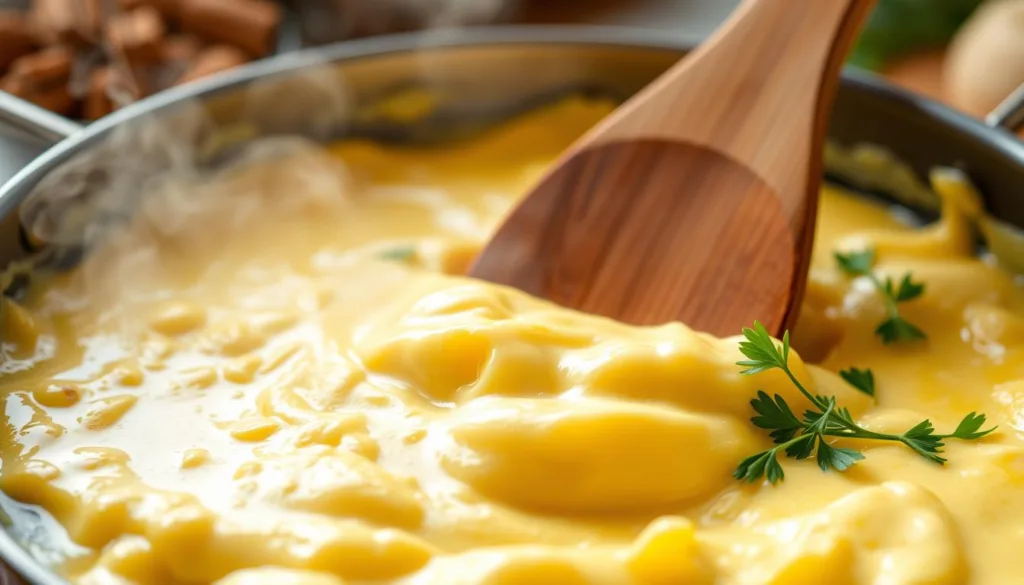
Getting perfect scrambled eggs is more than just cooking. Professional chefs use special techniques to make this dish amazing. They turn simple scrambled eggs into a culinary masterpiece.
The low and slow method is a game-changer for smooth eggs. It turns scrambling into a careful art. Cooking eggs slowly keeps them moist and creamy.
- Use medium-low heat consistently
- Stir eggs gently and slowly
- Remove from heat when slightly undercooked
The cornstarch trick is another secret for tender eggs. Mixing 1¾ teaspoons of cornstarch with milk before adding eggs stops eggs from becoming rubbery. This way, every bite is soft and tender.
“Cooking scrambled eggs is an art that requires patience and precision” – Culinary Expert
Pro chefs give specific tips for perfect eggs:
| Ingredient | Quantity | Purpose |
|---|---|---|
| Eggs | 3 large | Base of recipe |
| Milk | 1½ tablespoons | Moisture and softness |
| Cornstarch | 1¾ teaspoons | Prevents rubbery texture |
| Butter | 3 tablespoons | Rich flavor |
Remember, the key to perfect scrambled eggs lies in understanding these nuanced techniques and practicing them with care.
Common Mistakes to Avoid When Making Scrambled Eggs
Perfecting scrambled eggs is more than just cracking eggs into a pan. Many home cooks unknowingly make mistakes that ruin their breakfast. These errors lead to rubbery eggs, bland taste, and dry texture.
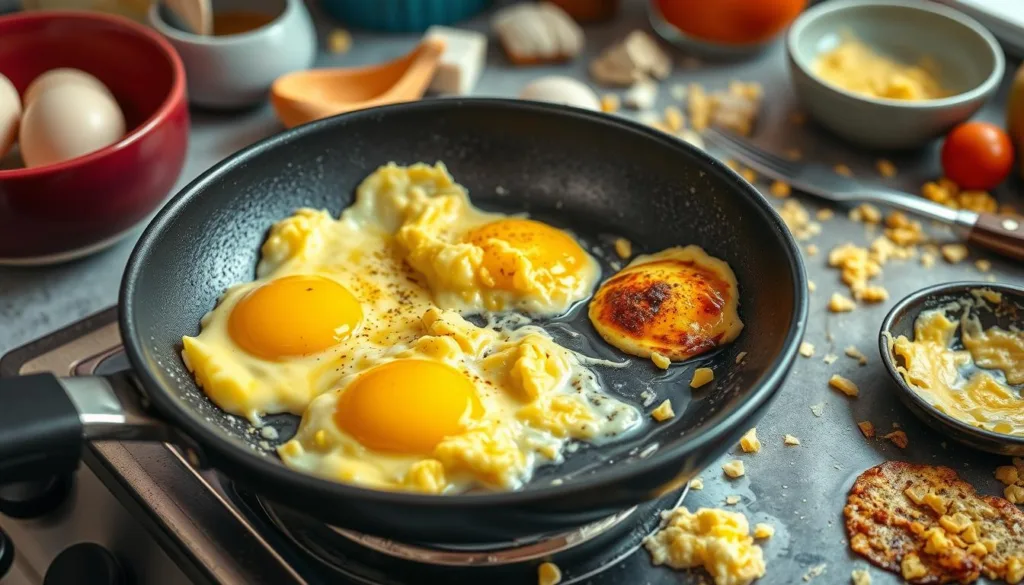
Knowing these common mistakes can improve your egg-cooking skills. Let’s look at the most frequent errors that can mess up your scrambled eggs.
Temperature Control Issues
High heat is the main reason for rubbery eggs. About 70% of home cooks accidentally overcook their eggs because of too much heat. Cooking on low to medium heat helps cook eggs gently and evenly, keeping their texture soft.
- Avoid high heat that causes rapid protein coagulation
- Use low to medium heat for creamy eggs
- Remove eggs from heat when slightly wet to prevent dryness
Seasoning Mistakes
Seasoning can make scrambled eggs go from bland to amazing. Interestingly, adding salt during mixing can absorb 30% more flavor than adding it at the end.
| Seasoning Technique | Flavor Impact |
|---|---|
| Salt added before cooking | 30% increased flavor absorption |
| Salt added after cooking | Minimal flavor enhancement |
Overcooking Problems
Overcooking often makes scrambled eggs dry. Professional chefs say to remove eggs from heat when they’re still a bit wet. This stops the eggs from becoming dry and rubbery, making them unappetizing.
“Eggs continue cooking even after removing from heat. Stop cooking when they’re still slightly moist.” – Culinary Expert
Avoiding these common mistakes will help you make scrambled eggs that are creamy, flavorful, and perfectly cooked every time.
Serving and Plating Suggestions
Take your scrambled eggs to the next level with smart serving tips. The right garnishes and side dishes can make a simple meal into a feast for the eyes and taste buds.
Garnish Options to Enhance Flavor
- Fresh herbs like chives, dill, or parsley
- Flaky sea salt for a sophisticated touch
- Cracked black pepper
- Microgreens for a delicate aesthetic
Your presentation is just as important as the cooking. A well-thought-out arrangement can make scrambled eggs a hit on social media, impressing everyone.
Ideal Side Dishes
| Side Dish Category | Recommended Options |
|---|---|
| Breads | Sourdough toast, brioche, whole grain bread |
| Proteins | Crispy bacon, turkey sausage, smoked salmon |
| Fresh Options | Mixed berries, avocado slices, roasted tomatoes |
Experts say to serve scrambled eggs immediately for the best taste and texture. Use a preheated plate to keep them warm without overcooking.
“The difference between good and great scrambled eggs is in the details of serving.” – Culinary Expert
Try out different garnishes and side dishes to find your favorite way to serve scrambled eggs. Remember, how it looks can make your meal even more enjoyable and memorable.
Scrambled eggs are a versatile breakfast option that pairs well with a variety of dishes. For a hearty start to your day, try them alongside the Sheepherder’s Breakfast, a filling meal packed with flavor. Looking for a lighter, healthier pairing? Check out this refreshing Quinoa Salad, which complements scrambled eggs perfectly. Or, if you’re in the mood for something indulgent, serve your eggs with these cheesy, savory Quesadillas for a delightful fusion of flavors. Explore these recipes to create your ideal breakfast spread!
Conclusion
Learning to make scrambled eggs is a tasty journey. With each try, you get better, turning simple eggs into a tasty meal. You can try different ingredients and flavors to make it your own.
Scrambled eggs are also good for you. They have about 91 calories per egg and lots of vitamins and minerals. They’re a great protein source for any meal.
Cooking is all about trying new things and having fun. You might like your eggs creamy or firmer. Start with the basics, then add new ingredients. Let your taste guide you to making the perfect scrambled eggs.
FAQ
What type of pan is best for making scrambled eggs?
A nonstick skillet or a well-seasoned carbon steel pan is ideal. They prevent eggs from sticking and ensure even cooking.
How do I make my scrambled eggs extra fluffy?
To make fluffy scrambled eggs, whisk them well and add a tablespoon of water for every 4 eggs. Cook on medium heat. You can also add a teaspoon of cornstarch in milk or a dollop of Greek yogurt for extra fluffiness.
How long should I cook scrambled eggs?
Scrambled eggs usually take 2-3 minutes to cook. Stop cooking when they’re still a bit wet. They will continue cooking from the heat. Avoid overcooking to keep them moist and fluffy.
Should I add milk or cream to my scrambled eggs?
Adding a small amount of liquid can make a difference. Water makes eggs fluffier, while cream adds richness. Start with about a tablespoon of liquid for every 4 eggs.
What type of eggs work best for scrambling?
Fresh eggs, especially pasture-raised or farm-raised, are best for creamy scrambled eggs. They produce better results and have a nicer texture than older eggs.
When should I season my scrambled eggs?
Season your eggs before cooking to ensure even salt and pepper distribution. Use kosher or sea salt and add it to the egg mixture before cooking.
Can I add other ingredients to my scrambled eggs?
Yes, but be careful. Cheese or vegetables can add water and change the texture. Add ingredients carefully and pre-cook watery vegetables to keep the eggs creamy.
What’s the best way to avoid tough scrambled eggs?
Avoid high heat and overcooking. Cook on medium heat and remove eggs when they’re still slightly wet. Use gentle folding to create soft, creamy curds.
How can I make my scrambled eggs more interesting?
Try garnishes like fresh herbs, flaky sea salt, or crème fraîche. Serve with toast, bacon, or fruit for a complete breakfast.
What’s the “low and slow” method for scrambled eggs?
The low and slow method cooks eggs over a double boiler, taking 15 minutes to an hour. It makes extremely creamy, delicate scrambled eggs with a custard-like texture.

Perfect Scrambled Eggs
Ingredients
- 2-3 large fresh eggs per serving
- 1-2 tablespoons unsalted butter or olive oil
- Pinch of salt to taste
- 1-1.5 teaspoons of water per egg optional
Instructions
- In a mixing bowl, whisk the eggs vigorously until frothy.
- Heat a nonstick skillet over medium heat and add butter, allowing it to melt until golden.
- Add eggs to the pan, reducing heat to low/medium-low.
- Gently stir the eggs with a spatula, pushing cooked edges towards the center.
- Cook for 2-3 minutes until eggs are slightly wet but almost set, then remove from heat.
- Season with salt just before serving and garnish as desired.

